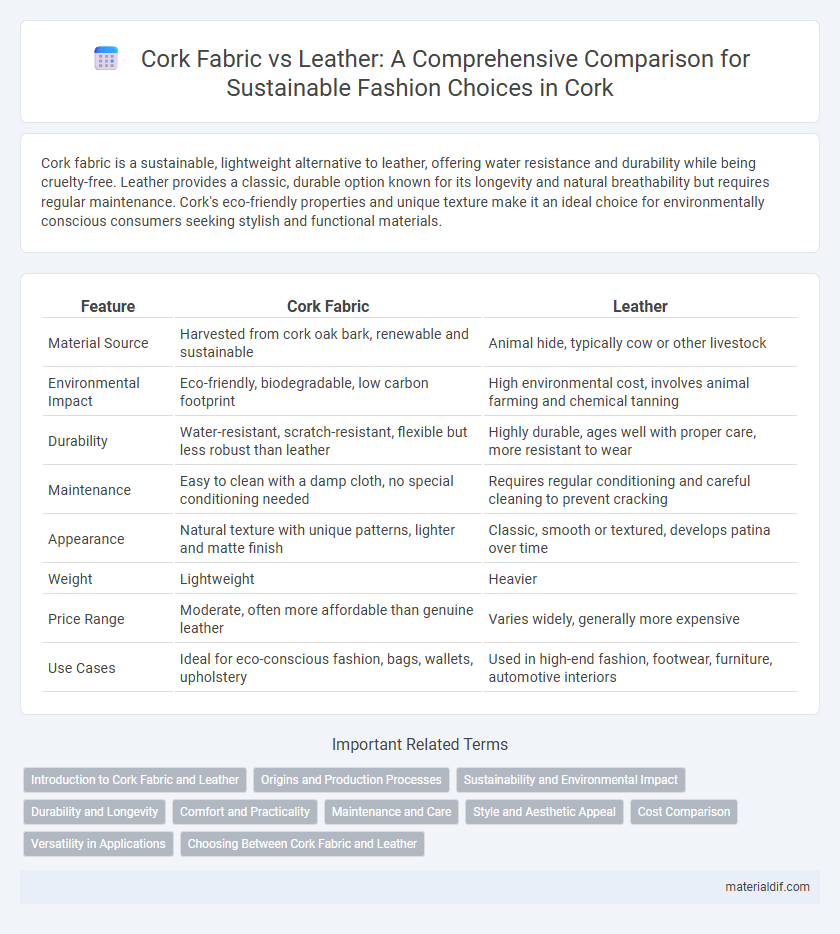Cork fabric is a sustainable, lightweight alternative to leather, offering water resistance and durability while being cruelty-free. Leather provides a classic, durable option known for its longevity and natural breathability but requires regular maintenance. Cork's eco-friendly properties and unique texture make it an ideal choice for environmentally conscious consumers seeking stylish and functional materials.
Table of Comparison
| Feature | Cork Fabric | Leather |
|---|---|---|
| Material Source | Harvested from cork oak bark, renewable and sustainable | Animal hide, typically cow or other livestock |
| Environmental Impact | Eco-friendly, biodegradable, low carbon footprint | High environmental cost, involves animal farming and chemical tanning |
| Durability | Water-resistant, scratch-resistant, flexible but less robust than leather | Highly durable, ages well with proper care, more resistant to wear |
| Maintenance | Easy to clean with a damp cloth, no special conditioning needed | Requires regular conditioning and careful cleaning to prevent cracking |
| Appearance | Natural texture with unique patterns, lighter and matte finish | Classic, smooth or textured, develops patina over time |
| Weight | Lightweight | Heavier |
| Price Range | Moderate, often more affordable than genuine leather | Varies widely, generally more expensive |
| Use Cases | Ideal for eco-conscious fashion, bags, wallets, upholstery | Used in high-end fashion, footwear, furniture, automotive interiors |
Introduction to Cork Fabric and Leather
Cork fabric, derived from the bark of cork oak trees primarily found in Portugal, is a sustainable, lightweight, and water-resistant material increasingly used in fashion and accessories as an eco-friendly alternative to leather. Leather, traditionally sourced from animal hides, offers durability, breathability, and a classic aesthetic but involves environmentally intensive processing and ethical concerns. Cork fabric's natural texture and renewable origins make it a unique choice for consumers seeking cruelty-free, biodegradable materials compared to the conventional use of leather.
Origins and Production Processes
Cork fabric originates from the bark of cork oak trees predominantly found in Portugal and Spain, involving a sustainable harvesting process that does not harm the tree. Leather production begins with animal hides, primarily from cattle, undergoing complex tanning processes that can impact the environment due to chemical usage. Cork fabric's renewable and eco-friendly harvesting contrasts with leather's resource-intensive and chemically dependent production methods.
Sustainability and Environmental Impact
Cork fabric, derived from the renewable bark of cork oak trees, offers a sustainable alternative to leather by being biodegradable and requiring minimal water and chemical usage during production. Leather manufacturing involves high water consumption, deforestation for cattle grazing, and chemical treatments that contribute to pollution and greenhouse gas emissions. Choosing cork fabric reduces environmental impact by promoting sustainable harvesting practices and lowering carbon footprint compared to traditional leather.
Durability and Longevity
Cork fabric exhibits remarkable durability due to its natural resistance to scratches and water, making it a sustainable alternative to traditional leather. Unlike leather, which can degrade over time with exposure to moisture and requires regular maintenance, cork maintains its structural integrity without cracking or peeling. This longevity makes cork fabric an ideal choice for eco-conscious consumers seeking a durable, low-maintenance material with a lifespan comparable to high-quality leather.
Comfort and Practicality
Cork fabric offers superior breathability and lightweight comfort compared to leather, making it ideal for warm climates and extended wear. Its natural water resistance and easy maintenance enhance practicality, requiring less care than leather, which can crack or stiffen over time. While leather provides durability and a classic aesthetic, cork fabric's flexibility and eco-friendly properties make it a more comfortable and practical choice for everyday use.
Maintenance and Care
Cork fabric requires minimal maintenance, needing only occasional wiping with a damp cloth to remove dirt and prevent staining, making it highly resistant to water and scratches. In contrast, leather demands regular conditioning and cleaning with specialized products to maintain its softness and prevent cracking or drying over time. Cork's natural antimicrobial properties reduce odor buildup, while leather may develop cracks and discoloration without proper care.
Style and Aesthetic Appeal
Cork fabric offers a unique, natural texture with a smooth, matte finish that complements minimalist and eco-friendly fashion styles, providing a warm, earthy aesthetic. Leather presents a timeless, polished look with rich color variations and a glossy sheen, often associated with luxury and classic sophistication. Both materials deliver distinct style advantages, with cork appealing to sustainable fashion enthusiasts and leather embodying traditional elegance.
Cost Comparison
Cork fabric is generally more affordable than leather, costing approximately 20-30% less per square meter due to its natural and sustainable production process. Leather prices fluctuate significantly based on quality, tanning methods, and source, often making it a pricier option for durability and luxury. Cork's cost-effectiveness is enhanced by lower maintenance expenses and eco-friendly credentials, appealing to budget-conscious consumers seeking sustainable alternatives.
Versatility in Applications
Cork fabric offers exceptional versatility in applications due to its lightweight, water-resistant, and eco-friendly properties, making it ideal for fashion accessories, upholstery, and automotive interiors. Leather, while durable and luxurious, is often preferred for high-end products like footwear, bags, and furniture but requires more maintenance and is less sustainable. Cork's adaptability in both casual and functional contexts contrasts with leather's traditional use in premium, long-lasting goods.
Choosing Between Cork Fabric and Leather
Cork fabric offers a sustainable, lightweight, and water-resistant alternative to leather, making it ideal for eco-conscious consumers seeking durability with a smaller environmental footprint. Leather provides unmatched strength, a classic texture, and long-lasting wear, often preferred for premium accessories and furniture due to its natural aging process. When choosing between cork fabric and leather, consider factors like environmental impact, maintenance requirements, and the intended use to select the most suitable material.
Cork Fabric vs Leather Infographic

 materialdif.com
materialdif.com